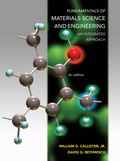
Fundamentals of materials science and engineering: an integrated approach
Callister, William D.
Rethwisch, David G.
INDICE: Chapter 1 - Introduction. 1.1 Historical Perspective 1.2 Materials Science and Engineering 1.3 Why Study Materials Science and Engineering? 1.4 Classification of Materials Materials of Importance-Carbonated Beverage Containers 1.5 Advanced Materials 1.6 Modern Materials Needs 1.7 Processing/Structure/Properties/Performance Correlations Chapter 2 - Atomic Structure and Interatomic Bonding. 2.1 Introduction 2.2 Fundamental Concepts 2.3 Electrons in Atoms 2.4 The Periodic Table 2.5 Bonding Forces and Energies 2.6 Primary InteratomicBonds 2.7 Secondary Bonding or van der Waals Bonding Materials of Importance-Water (Its Volume Expansion Upon Freezing) 2.8 Molecules Chapter 3 - Structures of Metals and Ceramics 3.1 Introduction 3.2 Fundamental Concepts 3.3 Unit Cells 3.4 Metallic Crystal Structures 3.5 Density Computations-Metals 3.6 Ceramic Crystal Structures 3.7 Density Computations-Ceramics 3.8 Silicate Ceramics 3.9 Carbon Materials of Importance-Carbon Nanotubes 3.10 Polymorphism and Allotropy Material of Importance-Tin (Its Allotropic Transformation) 3.11 Crystal Systems 3.12 Point Coordinates 3.13 Crystallographic Directions 3.14 Crystallographic Planes 3.15 Linear and Planar Densities 3.16 Close-Packed Crystal Structures 3.17 Single Crystals 3.18 Polycrystalline Materials 3.19 Anisotropy 3.20X-Ray Diffraction: Determination of Crystal Structures 3.21 Noncrystalline Solids Chapter 4 - Polymer Structures 4.1 Introduction 4.2 Hydrocarbon Molecules4.3 Polymer Molecules 4.4 The Chemistry of Polymer Molecules 4.5 Molecular Weight 4.6 Molecular Shape 4.7 Molecular Structure 4.8 Molecular Configurations 4.9 Thermoplastic and Thermosetting Polymers 4.10 Copolymers 4.11 Polymer Crystallinity 4.12 Polymer Crystals Chapter 5 - Imperfections in Solids 5.1 Introduction 5.2 Point Defects in Metals 5.3 Point Defects in Ceramics 5.4 Impurities in Solids 5.5 Point Defects in Polymers 5.6 Specification of Composition 5.7Dislocations-Linear Defects 5.8 Interfacial Defects Materials of Importance-Catalysts (and Surface Defects) 5.9 Bulk or Volume Defects 5.10 Atomic Vibrations 5.11 Basic Concepts of Microscopy 5.12 Microscopic Techniques 5.13 Grain Size Determination Chapter 6 - Diffusion 6.1 Introduction 6.2 Diffusion Mechanisms 6.3 Steady-State Diffusion 6.4 Nonsteady-State Diffusion 6.5 Factors That Influence Diffusion 6.6 Diffusion in Semiconducting Materials Material of Importance-Aluminum for Integrated Circuit Interconnects 6.7 Other Diffusion Paths 6.8 Diffusion in Ionic and Polymeric Materials Chapter 7 - Mechanical Properties 7.1 Introduction 7.2 Concepts of Stress and Strain 7.3 Stress-Strain Behavior 7.4 Anelasticity 7.5 Elastic Properties of Materials 7.6 Tensile Properties7.7 True Stress and Strain 7.8 Elastic Recovery after Plastic Deformation 7.9Compressive, Shear, and Torsional Deformation 7.10 Flexural Strength 7.11 Elastic Behavior 7.12 Influence of Porosity on the Mechanical Properties of Ceramics 7.13 Stress-Strain Behavior 7.14 Macroscopi
- ISBN: 978-1-118-06160-2
- Editorial: John Wiley & Sons
- Encuadernacion: Cartoné
- Páginas: 1008
- Fecha Publicación: 03/11/2011
- Nº Volúmenes: 1
- Idioma: Inglés
